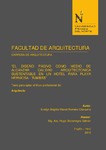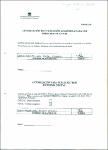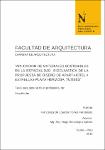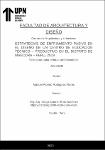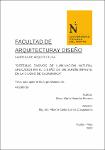El diseño pasivo como medio de alcanzar calidad arquitectónica sustentable en un hotel para Playa Hermosa - Tumbes.
| dc.contributor.advisor | Bocanegra Galván, Hugo | |
| dc.contributor.author | Romero Olavarría, Evelyn Brigitte Mavel | |
| dc.date.accessioned | 2016-09-03T23:51:31Z | |
| dc.date.available | 2016-09-03T23:51:31Z | |
| dc.date.issued | 2015-06-01 | |
| dc.identifier.citation | Romero, E. B. (2015). El diseño pasivo como medio de alcanzar calidad arquitectónica sustentable en un hotel para Playa Hermosa - Tumbes. (Tesis de licenciatura). Repositorio de la Universidad Privada del Norte. Recuperado de http://hdl.handle.net/11537/6404 | es_PE |
| dc.identifier.other | 728.5 ROME | es_PE |
| dc.identifier.uri | https://hdl.handle.net/11537/6404 | |
| dc.description.abstract | RESUMEN El presente informe se refirió al diseño pasivo como medio de alcanzar calidad arquitectónica sustentable en un hotel para Playa Hermosa Tumbes y tuvo como propósito investigar los principios del diseño pasivo donde el enfriamiento de ambientes es uno de ellos, y como parte de arquitectura sustentable aprovechar los recursos naturales al máximo, para sí poder minimizar el impacto ambiental de esta propuesta. En este proyecto no solo se trabaja con el ahorro energético, primero se realiza una construcción que ahorra recursos, minimizamos las necesidades energéticas a traves del diseño pasivo (diseño, orientación y uso de aislamientos). Con estas pautas se realizaron el estudio de casos internaciones de hoteles en playa y con similares características de climas. Teniendo el análisis se llegó a la conclusión que para el diseño del hotel se utilizará un material que permita una rápida construcción además de que proporciona inercia térmica y reduce la demanda energética de la construcción. Así como también el uso de plantas de aguas residuales y potables, además de una planta desalinizadora aprovechando el agua del mar. | es_PE |
| dc.description.abstract | ABSTRACT This report referred to the passive design as a means of achieving sustainable architectural quality in a hotel for Playa Hermosa Tumbes and was to investigate the principles of passive design environments where cooling is one of them, and as part of sustainable architecture leverage natural resources to the maximum for themselves to minimize the environmental impact of this proposal. This project not only working with energy saving, first construction that saves resources is done, we minimize the energy needs through passive design (design, orientation and use of isolates). With these guidelines the study of hotels cases Beach Hotels with similar climates were performed. Taking the analysis concluded that the hotel design a material that allows rapid construction plus it provides thermal mass and reduces the energy demand of the building will be used. As well as the use of plant wastewater and drinking water, and a desalination plant using water from the sea. | es_PE |
| dc.description.uri | Tesis | es_PE |
| dc.language.iso | spa | es_PE |
| dc.publisher | Universidad Privada del Norte | es_PE |
| dc.rights | info:eu-repo/semantics/openAccess | es_PE |
| dc.source | Universidad Privada del Norte | es_PE |
| dc.source | Repositorio Institucional - UPN | es_PE |
| dc.subject | Hoteles | es_PE |
| dc.subject | Arquitectura | es_PE |
| dc.subject | Espacios (arquitectura) | es_PE |
| dc.subject | Diseño arquitectónico | es_PE |
| dc.subject | Arquitectura del paisaje | es_PE |
| dc.title | El diseño pasivo como medio de alcanzar calidad arquitectónica sustentable en un hotel para Playa Hermosa - Tumbes. | es_PE |
| dc.type | info:eu-repo/semantics/bachelorThesis | es_PE |
| thesis.degree.grantor | Universidad Privada del Norte. Facultad de Arquitectura y Diseño | es_PE |
| thesis.degree.level | Título Profesional | es_PE |
| thesis.degree.discipline | Arquitectura | es_PE |
| thesis.degree.name | Arquitecto | es_PE |
| dc.publisher.country | PE | es_PE |
| dc.subject.ocde | https://purl.org/pe-repo/ocde/ford#6.04.08 | es_PE |
| thesis.degree.program | Pregrado | es_PE |
| dc.description.sede | Trujillo El Molino | es_PE |
| renati.discipline | 731026 | es_PE |
| renati.level | https://purl.org/pe-repo/renati/level#tituloProfesional | es_PE |
| renati.type | https://purl.org/pe-repo/renati/type#tesis | es_PE |
Files in this item
This item appears in the following Collection(s)
-
Tesis [153]


